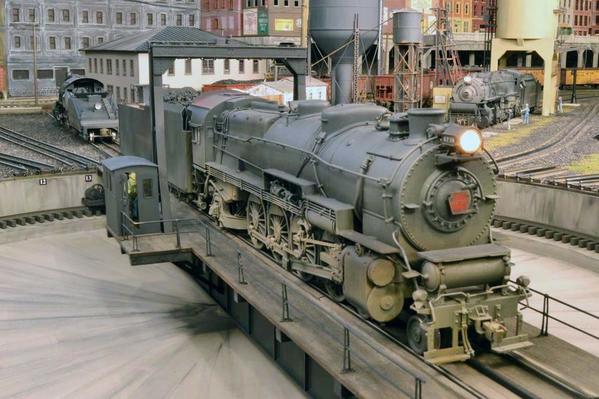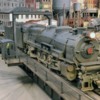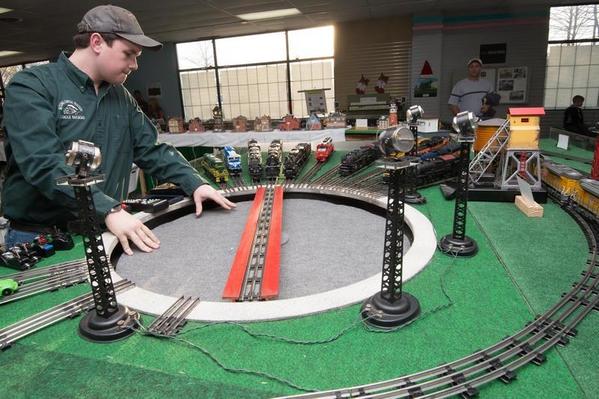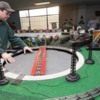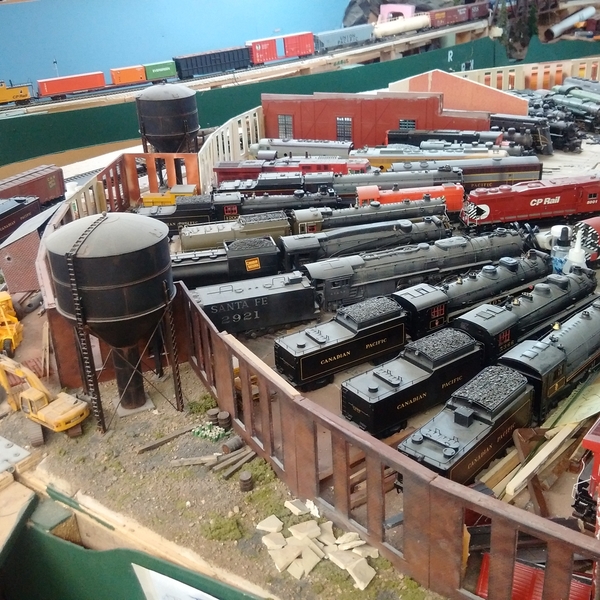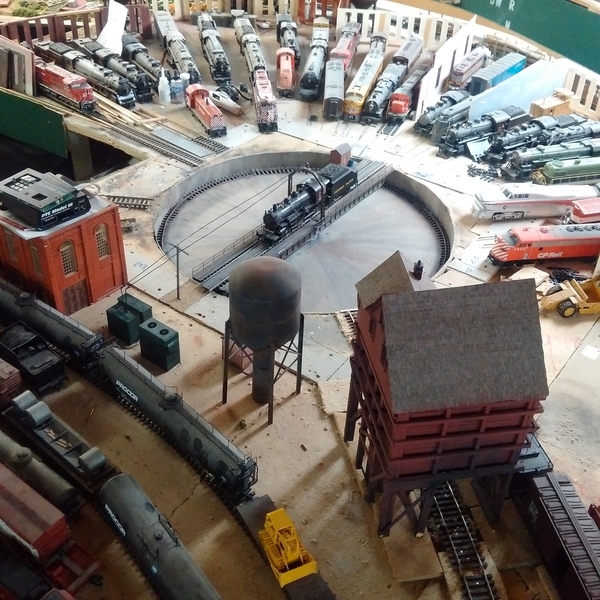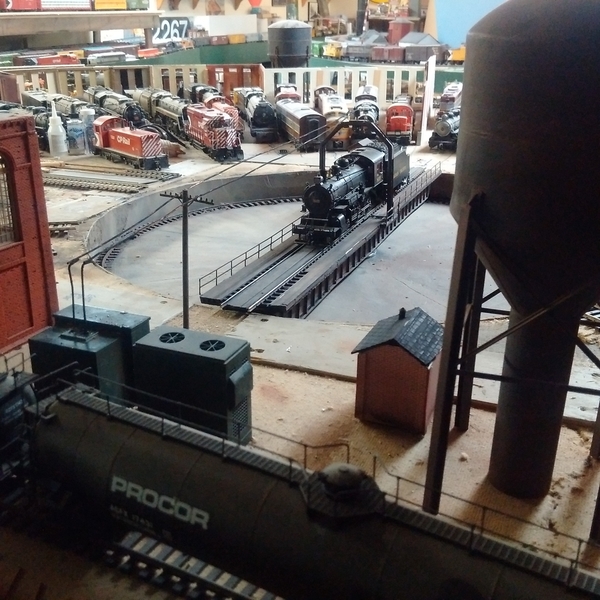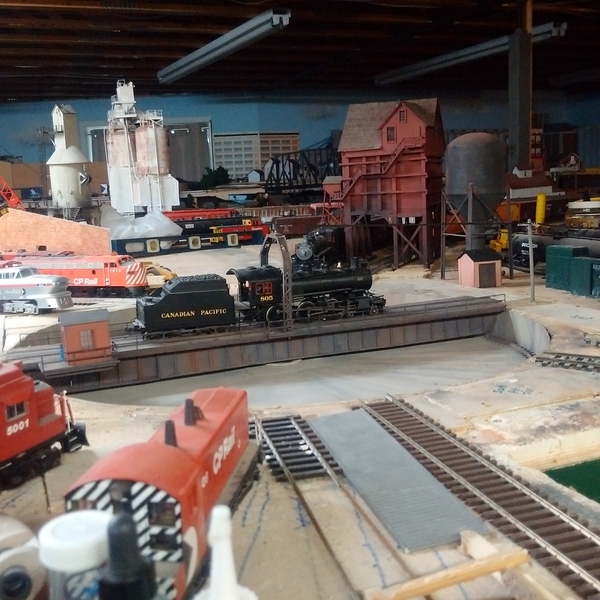Hello! I am revamping/remodeling my layout and would like to add a turn table. Atlas made a good looking one a few years back but seems to have discontinued it. Does any body know why they stopped building it? Is there any other available options for an O gauge turntable? Any help would be appreciated.
Replies sorted oldest to newest
Steel Wheels posted:Hello! I am revamping/remodeling my layout and would like to add a turn table. Atlas made a good looking one a few years back but seems to have discontinued it. Does any body know why they stopped building it?
According to a number of posts here on OGR, it was VERY unreliable.
Is there any other available options for an O gauge turntable? Any help would be appreciated.
Two of the VERY best available: Ross Custom Switches, and Milhouse River Studios (both forum sponsors).
Thank you Hot Water! I am familiar with Ross because I have a combination of Ross and Curtis swithches on my old layout. I will check both out!
Millhouse River Studios does some RR specific turntables such as the PRR and UPRR. So if you have a favorite RR, you might want to check them out!
I have a old Brand New still in the box Bowser I am considering selling if you are interested. It includes an indexing kit and bridge work.
Rick,
Might help Wheels to know the size of your turntable.
For what's worth, I purchased a Bowser (32" I think) from a friend, and it gives me nothing but trouble, even after I up-graded the drive to a Milhouse River cog belt drive. The Bowser has WAY TOO SMALL of a drive shaft, while I believe both the Millhouse River and the Ross turntables have 1" diameter drive shafts.
I agree with Hot Water, the real players for your $$$$$ are Ross and Millhouse, both OGR Sponsors....My friends in Owensboro, Ky., have the Millhouse turntables. One has a 28 inch, the other a 34 inch, both are Awesome. The Atlas O table was a 24 inch flat top mounted table...Good for short steamers, and Diesels. My suggestion is check these out and plan your location.
I to have a Bowser 32 inch because I purchased mine 20 years ago, before these models became available. I did retrofit mine with a scale pit rail, and a ball bearing 3/8 drive shaft, with floating sprung bogies...I use PTC 3 Indexing, its keypad control...I would have bought the others mentioned, hands down..
Attachments
Thanks for all the help guys, great photos and ideas! The prices are a bit steep but I have learned from past experience that bargain prices for shoddy products are never a good deal. Thanks Rick for the offer but I think I will go with the Ross or the Millhouse. Ross has a new under construction website that doesn't give much information, but I emailed them and asked for details.
I have waited a long time to expand and refurbish my layout and the turntable and roundhouse are key components to my dream layout. You have all been very nice to me and I hope to keep you updated on the progress with the layout. Have a wonderful Independence Day!
If you decide you really want an Atlas turntable after looking at the others, I may know where there is one available. I am pretty sure it is 'new old stock'. The vendor (my LHS) is not a forum sponsor, so email me if you are interested. My email is in my profile.
I would agree with the others that the Ross and Millhouse TT's are definitely very nice and much better than the Atlas TT, but they are also priced accordingly. I guess the old saying 'you get what you pay for' would definitely apply here.
Millhouse River is what I have - 32'. Works fantastic. Al always is at York with demo's of his Turntable and other products including indexing kits, transfer tables.
Steel Wheels
Have you considered building a turntable from scratch. It is not that hard and a lot of fun and satisfaction and also way less expensive. The design, details and operation will depend on your skills.
I have had a scratch built turntable for over 39 years and it cost less than $10 and is 027 gauge and 17 5/8 inches long and driven by a used clothes dryer belt.
If you do not want to place the TT close to the edge of you layout and be restricted by location due to the length of the clothes dryer belt one can power the turntable with a used DC electric drill or screw driver motor. The drill motor could be powered with a small cheap HO DC transformer in both directions. This would be easy to power the TT with a shorter belt and pulley on the drill and the the TT could be located anywhere.
A real rails can be used to support the end of the TT deck.
Check this topic for post 9 for details of mine on my 027 layout.
https://ogrforum.ogaugerr.com/...ra-027-layout?page=1
Post 9 below
Charlie
Post 9 6-25-2016
Turntable Construction
The center piece of the layout is the scratch built, inexpensive turntable and roundhouse. Designing and building the turntable was the most fun part of the whole train layout and well worth the time and effort as it provides much operation interest and fun. The Turntable was built during the initial layout construction in 1977 in Kingston Jamaica.
The turntable rotates on a 6 inch diameter lazy Susan ball bearing and rotation is by a hand crank driving a pulley beneath the turntable using a spare or used clothes dryer drum belt. Track alignment is the realistic, "line it by eyeball" method and roundhouse track selection is by a rotary switch. A momentary push button switch is used to activate the selected RH track and the TT track. A light in the TT shack comes on with the activation of the TT track and indicates power is on.
Location of the control panel and the turntable should be fairly close to each other for two reasons. One is the use of a clothes dryer belt will require it to be close. The other is it is helpful for the engineer to be close at hand to correct derailments and to see the turntable as eyesight is used to align the TT and the tracks.
Picture of TT with TT crank (red knob) and Control Panel
Picture shows the track with crane car and caboose align with the TT and the off track
Two pieces of 027 track or 17 5/8 inches was chosen for the turntable bridge length. 22 inches would have been better but space was in a premium and 18 inches diameter will handle all of my engines and coal tenders. I cut a 18 inch diameter circle in my train board using a sabre saw and used the ¾ inch thick 18 in diameter cutout as a pulley by adding a rim of 1/8 inch Masonite around both edges as pulley flanges sticking out about ½ an inch.
A recessed ring around the turntable hole, about 1&1/2 inch deep, was installed on the bottom of the hole and a 1/2" plywood bottom was added. A 3/8" hole was centered in both TT bottom and the pulley. A 2"x 2" x 3/4 inch block was drilled to take a 3/8 threaded hollow lamp rod in the center. The block and rod were mounted about 1 inch from the rods end and drilled for a 2 inch long finish nail. The block was glued and screwed to the pulley in the center. A 6" lazy Susan bearing (Ace or Home Depot for $4) was screwed to the top of the pulley. Holes were drilled through the pulley where the screws on the other flange of 6” lazy Susan bearing. These holes allow the bearing to be screwed to the underside of the pit bottom.
I did most of the work on the TT with my train board section standing on edge, leaning against a wall. To build a TT to an existing permanent layout on legs would require lots of work under the table and looking up. In such a case one might want to build two foot or so module to construct the TT and install as a unit.
The lazy Susan bearing will hold all the weight of the pulley and take the side trust from the clothes dryer belt. The 3/8” threaded rod allows wire to feed power to the TT bridge and to secure the bridge to the pulley beneath the TT pit.
The 3/8" dia. threaded hollow lamp rod was installed through the pulley and the rod was pinned to the pulley with a nail. The rod was measured to the length needed to go through the pulley, block, TT bottom and to the top of the TT bridge minus a ¼ inch, sawed off, and a hole drilled through the bridge to be able to pin the rod to the TT bridge to be built.
A turntable bridge was made out of wood and the bridge was pinned to the lamp rod with a finishing nail. The 3/8” lamp rod is anchored to the bottom of the 18“ pulley and on top of the TT bridge with two lamp round thumb nuts.
Small wheels were made for the ends of the Turntable Bridge to transfer the weight of the bridge and locomotive with coal tender to floor of the TT pit (I used some small ball bearings I had for wheels).
See picture
A pair of wires was run up through the lamp rod and soldered to the outside and middle rail of the track that was put on the TT bridge. Some slack was left in the wire and a type of disconnect like a plug or spring clips ( I used two electrical connectors cut from old 9v batteries) was installed to allow removal of wire to unwind the wire if it gets twisted too much (also try not to keep going is one direction too much!)
Picture of 18"dia. Pulley under Turntable with Clothes Dryer Belt and wires from TT Bridge
Tracks were added to store trains around the TT being careful of spacing between tracks. The tracks were wired to a Radio Shack rotary 10 position switch to select the track to be powered. A momentary contact push button switch was installed on the control panel and wired in series to allow the selected track and turntable bridge track to only be powered when this switch is held down.
I used a spare electric clothes dryer belt that is about 3/8" wide and 1/8"thick and about 8 to 10 feet in total length (not diameter). It is super strong. I made a hand crank out of a 6" long 1/4" carriage bolt as the driving pulley with disk and knob held on to the disk with a Tee nut and locking nut as the crank. I used over sized Tee nuts for shaft sleeves for the shaft, top and bottom. A small pulley was made for the shaft from a ¼ inch ID radio shaft coupling and two brass grommets soldered together to make a Vee to give more bit on the belt by the small shaft.
Picture of Hand Crank Vee pulley made from radio tuner shaft coupling and brass grommets
I made a 2" dia. take up pulley assembly and used a threaded rod to move it to make and adjust the tension in the dryer belt. I installed a 3" dia. pulley to make an S in the belt routing to allow belt tensioning. A 2” dia. pulley was used to make the belt stay about ½ inch apart after coming of the ½ inch Vee pulley on the hand crank to insure good 180 degree contact with the Vee pulley. Pulleys are made from 1/2 inch plywood with flanges of 1/8 inch Masonite having polyethylene next to wood from coffee can lids.
Picture of Belt Routing - Belt length total is 8 to 10 ft not diameter on drawing.
Picture of Pulleys and Belt - Tension adjuster on bottom belt wood box with metal strap
Note that one track aligns with the TT and the approach track. This is the only track that a wrecker caboose and crane car can be sent over the TT and be stored around the TT. I made sure to leave this track outside of my future Round house to be built and detailed later.
Picture of Track that will allow work caboose and crane car to be stored
I added details like the lighted TT operator shack, ladders on the bridge to the pit made from cut up N gauge track ties, a TT bridge central tower for overhead wire with ladder, pigeons and poop, and Sharpie penned in rail and ties in the TT pit.
TT bridge has 1/8 inch smooth Masonite deck, grooved with knife to look like wood planks and painted buff to look like wood. Some sieved coarse sand was glued into the pit bottom.
Picture of Turntable with center mast and ladder, exposed ties, birds, and pit track
This project takes time, planning and careful measurements to make it all work. Care must be given to aligning and screwing down the tracks so derailments are few or at least blamed on the TT operator !
The TT really did cost me less than $10 since I had a spare clothes dryer belt. You could get a belt from a junked dryer, as a used belt is plenty good for this. Buy a new one for your current dryer and use the old one for the TT !
The TT has worked well since 1977 or almost 39 years. It would not turn in 2015 and after investigation the cause was a broken solder joint on one of the grommets on the Vee pulley. The original was soldered with a soldering gun (the only soldering tool I had) and it lasted 38 years. I re-soldered the Vee with a propane torch, with a solder iron tip, that gets much hotter.
Charlie
I have a "modified" Bowser that is controlled with an antenna motor. THE PROBLEM is the rotational sway, Once I rotate the track to a spur it fails to lock in-position and has some rotational play. This occurs because the rotating track is supported in the center post and not at each end of that track on the circular pit track like the Ross and Millhouse.
Build vs. buy .... If your goal is detailed scale appearance and automated operation, my recommendation is the budget for the cost and buy.
I built a 34.5" (BigBoy sized) turntable years ago with specific goals for use in Tinplate Tracker modular club layouts. To that end, the turntable has to be easily handled in and out of the van and into venues, and usable by all operators including youngsters.
My turntable module is 4" thick, 48" on each side, and I can lift it solo. (To stand it up with legs attached, a second person is needed).
Some design decisions and lessons learned:
The track and appearance is Tinplate. Considering the packing and transport-related wear and tear on this module, scale track and details would suffer.
I decided to use a Dobsonian telescope technique where the turntable bridge is fixed to a rotating disk that rides on Teflon pads. The rotation is silky and stays put when the ever-reliable armstrong motor (manual) disengages. No operator training is needed to use the turntable and eyeball indexing mechanism.
Experimentation with motorization was not satisfactory. With the approach I used, the gear motor needed to be attached during module setup (adding to layout setup/teardown effort) and heavy articulated locomotives slipped/stalled the mechanism. The stalling issue could be addressed but the simplicity of manual operation won out. (After watching turntable operations at an Owosso steam fest, I know that turntable drive slipping is prototypical).
I chose to not use slip rings for bridge power and I have sufficient slack in the feed wires to let them twist up as the turntable is rotated. The feed wires are untwisted when the module is setup.
Wiring power to storage tracks and control panel is tedious. Plan ahead for this.
The turntable pit and rotating disk were machined using a "router on a stick" technique for circle cutting.
To secure storage track ends at the turntable pit, I drilled holes in the tinplate track flanges and drove small wire nails through. This has held up over the years much better than track spikes.
Considering the hours I spent building and tuning the turntable, the Ross and Millhouse turntables are bargains if you are installing in a fixed layout. For a module, neither commercial model meets my requirements for portability (weight, bulk) so it is DIY if you need something bigger than the Atlas turntable.
John
Attachments
Tracker John posted:Build vs. buy .... If your goal is detailed scale appearance and automated operation, my recommendation is the budget for the cost and buy.
I built a 34.5" (BigBoy sized) turntable years ago with specific goals for use in Tinplate Tracker modular club layouts. To that end, the turntable has to be easily handled in and out of the van and into venues, and usable by all operators including youngsters.
My turntable module is 4" thick, 48" on each side, and I can lift it solo. ....
I decided to use a Dobsonian telescope technique where the turntable bridge is fixed to a rotating disk that rides on Teflon pads. The rotation is silky and stays put when the ever-reliable armstrong motor (manual) disengages. No operator training is needed to use the turntable and eyeball indexing mechanism.
Experimentation with motorization was not satisfactory. With the approach I used, the gear motor needed to be attached during module setup (adding to layout setup/teardown effort) and heavy articulated locomotives slipped/stalled the mechanism. The stalling issue could be addressed but the simplicity of manual operation won out. (After watching turntable operations at an Owosso steam fest, I know that turntable drive slipping is prototypical).
I chose to not use slip rings for bridge power and I have sufficient slack in the feed wires to let them twist up as the turntable is rotated. The feed wires are untwisted when the module is setup.
Tracker John,
do you have any more pictures of this, including from the underside? I really like this idea. I also belong to a modular group, although I would consider such a project for home use. I have plenty of woodworking tools, and am quite familiar with the router on a stick approach to making circles.
Do you have any handwheel crank mechanism at all, or do you simply reach in and spin it?
jhz563
Doing it over I would likely go with the Ross turntable. Mine is a Bowser that I have had for many years. After a few upgrades, it works great. Using a "straight thru" track enables longer engines to be stored in the yard. Mine is a 24" and can accommodate most all of my single unit engines. Controlled by TMCC and close to the edge of my layout makes it fun to use. It is the centerpiece of my layout. Best of luck choosing a turntable for your layout!
Attachments
Steel Wheels posted:Hello! I am revamping/remodeling my layout and would like to add a turn table. Atlas made a good looking one a few years back but seems to have discontinued it. Does any body know why they stopped building it? Is there any other available options for an O gauge turntable? Any help would be appreciated.
There is a nice looking TT available right now on the for sale forum. I have no affiliation with the seller, just thought i would mention it.
jhz563,
The underside of the turntable pit is a piece of 1/4" ply stiffened with 1x1s where the 8 Teflon pads support the weight of the rotating disk. the disk is 34" diameter with a ring of Formica glued on and the Formica rides on the Teflon pads. The center post is 3/4" copper pipe and the power wires pass through the pipe.
The design is very similar to the base of a rocker box in a Dobsonian telescope (Google how to build a Dobsonian telescope). Performance is the same as my telescopes - silky rotation and stays put when the push stops.
My concern during construction was how to keep the weight to a minimum so I used Luan ply for the deck and disk ... two layers glued at right angles. A lot of extra effort went into gluing this up perfectly flat but the disk does not stay flat (however, this does not effect operation).
If weight is not a concern, I would cut the deck+disk out of countertop laminate and use a truss bridge for a pit-less turntable.
John
I have a Ross 24" turntable with the indexing feature, and am delighted with it. It's built amazingly solidly. Worth the money.
The turntable for my layout started life as a bowser 32" for turning the long locos. It had ''issues'' from the start! Drive system and motor were in desperate need of re doing. Here's what I did....first I welded together a new metal bridge, wood doesn't hack it. Secondly, I turned a new center pin and welded that to the 'bridge' sides. No chance of slippage! Thirdly, I turned a coller/ sleeve that was 4" long. When the center pin is inserted into the ''sleeve'' the tolerance is very minimal. I greased the shaft to be sure it would turn freely. The center pin is turned down to fit the Ross Costom Switches laser cut drive gear, belt and cog. Now, this 'bridge' fitted into the sleeve, allows you to force down on the bridge ends with pressure and ''not have any slop or up and down play'' to it. There will be, but not added yet, a support wheel system on each end but is NOT Required to be functional. With the Ross drive system connected, this system drives very smoothly and will handle the heaviest loco I have, a Max Gray 2-8-8-4. If you do not have access to a lathe, I would recommend a good machinist. He can set you up if you started out like me. Here's some pictures.....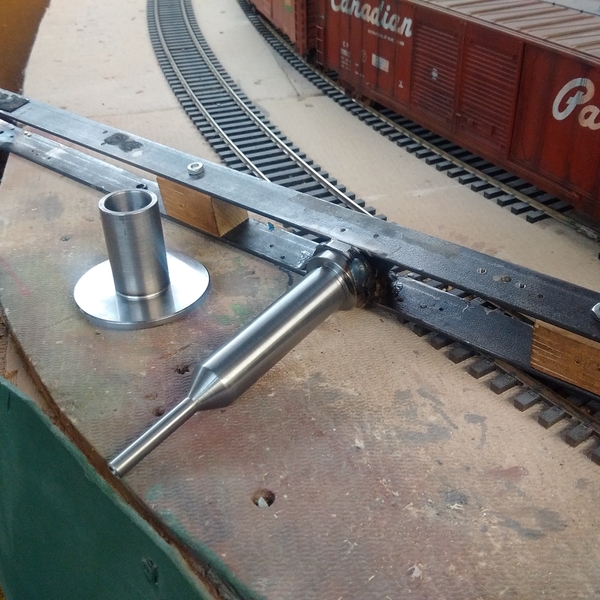
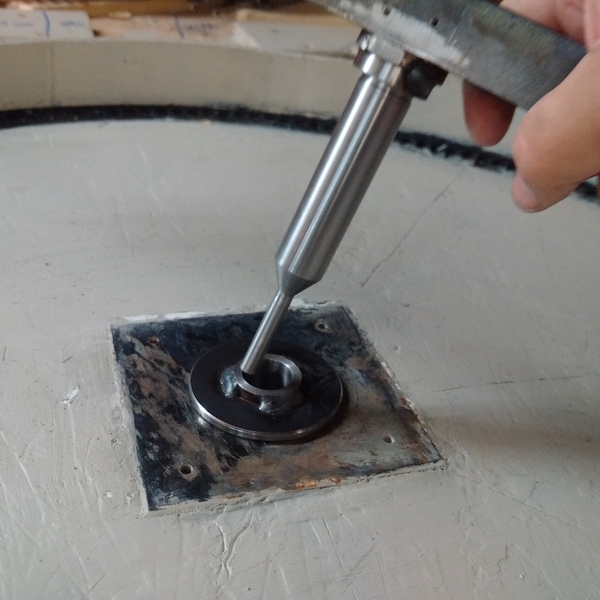
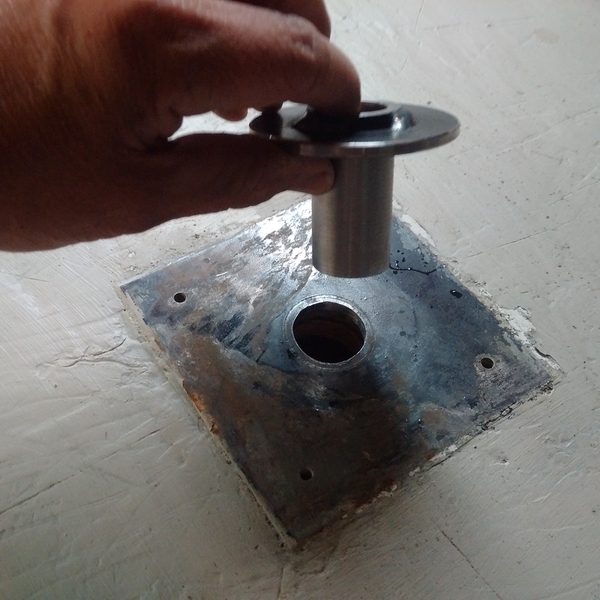
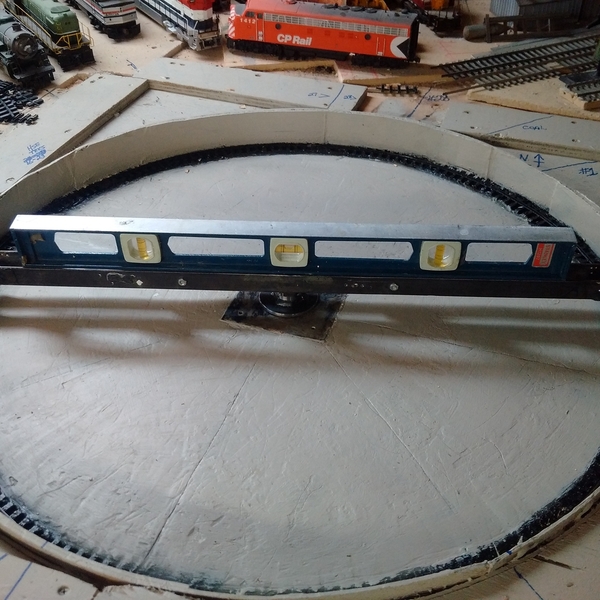
Attachments
I recently purchased and am in the process of installing a Millhouse River turntable in my existing layout. I chose MR based upon the recommendations of others as to their reliability, construction details, strength, indexing system and overall performance. It can also be integrated into a Legacy system if that is a factor for you.
At present, the circle for the TT has been cut and temporarily installed into the layout while I work out permanent mounting and leveling issues (my problem, not MR's).
Based upon what I have been able to observe about it to this point, I believe it was money well spent and would urge you to spend some time going through their website thoroughly and contact Al with any questions.
Further to my previous report on the turntable and roundhouse / steam facilities. Here are some ' present day ' progress photos. ( shown above). The turntable 'bridge' hugs close to the pit floor as they should . The ' stall ' tracks still need to be laid out. The roundhouse walls are made from a casting mold and the coal tower is built from a Canadian Pacific blue print, the plan was drawn out in 1 / 4 " so it gave me a full size view as it was constructed. On a suggestion from my wife, she said I should cover the roundhouse roof with plixi glass, so visitors can look in and see the locos and frame work details. That project will soon begin.
Steel Wheels, My email is in my profile. I have one new in box, E-mail me and I will tell you what I know about them. ( I did pull it out to test. ) I decided to do something else.
I already pulled the trigger on a Ross Turntable and have it installed. Thank you all for thinking about me and I am sorry I have been negligent in getting back to you. It seems that with all the time I have had with this staying home and being safe stuff I would have devoted more time to the forum. But it seems all kinds of things fill up that space. I will try to do better (fingers crossed!).
Wheels
If anyone out there has the Ross Custom Switches turntable electronic indexing key pad system, I would appreciate knowing what the ''wall plug power supply'' is rated at. Example...what is the output voltage that plugs into the ''red brain box'', (6v-9v or 12volt) and is that AC or DC . Also, what is the center plugs tip (-) negative tip or (+) positive tip . Somehow the parts sent to me neglected to include that wall plug transformer. Steve has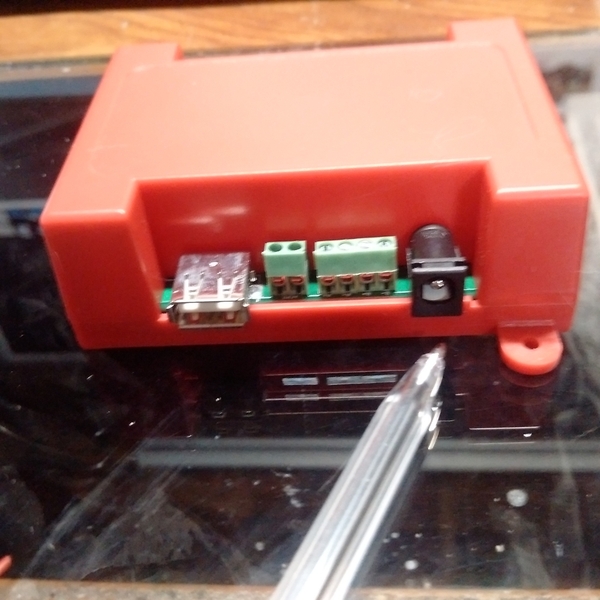
 been unavailable at Ross to answer me so i'm reaching out to anyone with this indexing system. Here's a picture of the 'red box'...... . Thanks guys, I appreciate any information on this. I have a universal wall power supply that is adjustable, but i'd hate to burn out any electronics guessing at it.
been unavailable at Ross to answer me so i'm reaching out to anyone with this indexing system. Here's a picture of the 'red box'...... . Thanks guys, I appreciate any information on this. I have a universal wall power supply that is adjustable, but i'd hate to burn out any electronics guessing at it.




![20170630_173137[2] 20170630_173137[2]](https://ogrforum.ogaugerr.com/fileSendAction/fcType/0/fcOid/73509797207318402/filePointer/73509797208273984/fodoid/73509797208273980/imageType/MEDIUM/inlineImage/true/20170630_173137%255B2%255D.jpg)
![20170630_173137[2] 20170630_173137[2]](https://ogrforum.ogaugerr.com/fileSendAction/fcType/0/fcOid/73509797207318402/filePointer/73509797208273984/fodoid/73509797208273980/imageType/SQUARE_THUMBNAIL/inlineImage/true/20170630_173137%5B2%5D.jpg)
